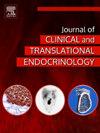Predicting accelerated fetal growth in pregnancy: beyond maternal hyperglycemia – The role of prothymosin-α, inflammatory cytokines, and angiogenic factors
IF 3.3
Q1 ENDOCRINOLOGY & METABOLISM
Journal of Clinical and Translational Endocrinology
Pub Date : 2025-06-20
DOI:10.1016/j.jcte.2025.100404
引用次数: 0
Abstract
Aim: This study investigates prothymosin-α (ProT-α), an immunomodulatory protein, as a potential biomarker for insulin resistance in gestational diabetes (GDM), and as a predictor of fetal growth by 20 weeks of gestation (wg). Methods: Forty-six women with singleton pregnancies were classified into GDM (n = 8) and normal glucose tolerance (NGT; n = 38) groups based on 75 g OGTT results. Maternal glucose, insulin, cytokines, and ProT-α levels were measured, and fetal growth was assessed by ultrasound at 20 wg, focusing on abdominal circumference (AC) and estimated fetal weight (EFW) percentiles. Results: Women with GDM were older, had a higher BMI, glucose, and insulin levels, with fetuses showing higher AC and EFW percentiles. IL-8, TNFα, and IL-1α were lower in the GDM group, while ProT-α was also lower but not significantly. ProT-α inversely correlated with EFW percentiles, independent of GDM. Regression analysis identified 2-hour post-load glucose, VEGF, and EGF as positive predictors of fetal growth acceleration, while IL-10 and ProT-α were negative predictors. Conclusions: Fetal growth is influenced by maternal glucose, inflammation, and angiogenesis. ProT-α may serve as an independent biomarker for predicting fetal growth in early pregnancy, suggesting further investigation into its role in GDM, obesity, and insulin resistance.

预测妊娠期胎儿生长加速:超越母体高血糖-胸腺蛋白酶-α、炎症细胞因子和血管生成因子的作用
目的:研究胸腺素原-α (ProT-α)是一种免疫调节蛋白,作为妊娠糖尿病(GDM)胰岛素抵抗的潜在生物标志物,并作为妊娠20周(wg)胎儿生长的预测因子。方法:将46例单胎妊娠妇女分为GDM组(n = 8)和正常糖耐量组(NGT;根据75 g OGTT结果n = 38)组。测量母体葡萄糖、胰岛素、细胞因子和ProT-α水平,并在20 wg时通过超声评估胎儿生长情况,重点关注腹围(AC)和估计胎儿体重(EFW)百分位数。结果:患有GDM的女性年龄较大,BMI、葡萄糖和胰岛素水平较高,胎儿AC和EFW百分位数较高。GDM组IL-8、TNFα、IL-1α降低,ProT-α降低,但差异不显著。ProT-α与EFW百分位数呈负相关,与GDM无关。回归分析发现负荷后2小时葡萄糖、VEGF和EGF是胎儿生长加速的阳性预测因子,而IL-10和ProT-α是阴性预测因子。结论:胎儿生长受母体血糖、炎症和血管生成的影响。ProT-α可能作为预测妊娠早期胎儿生长的独立生物标志物,提示其在GDM、肥胖和胰岛素抵抗中的作用有待进一步研究。
本文章由计算机程序翻译,如有差异,请以英文原文为准。
求助全文
约1分钟内获得全文
求助全文
来源期刊

Journal of Clinical and Translational Endocrinology
ENDOCRINOLOGY & METABOLISM-
CiteScore
6.10
自引率
0.00%
发文量
24
审稿时长
16 weeks
 求助内容:
求助内容: 应助结果提醒方式:
应助结果提醒方式:


